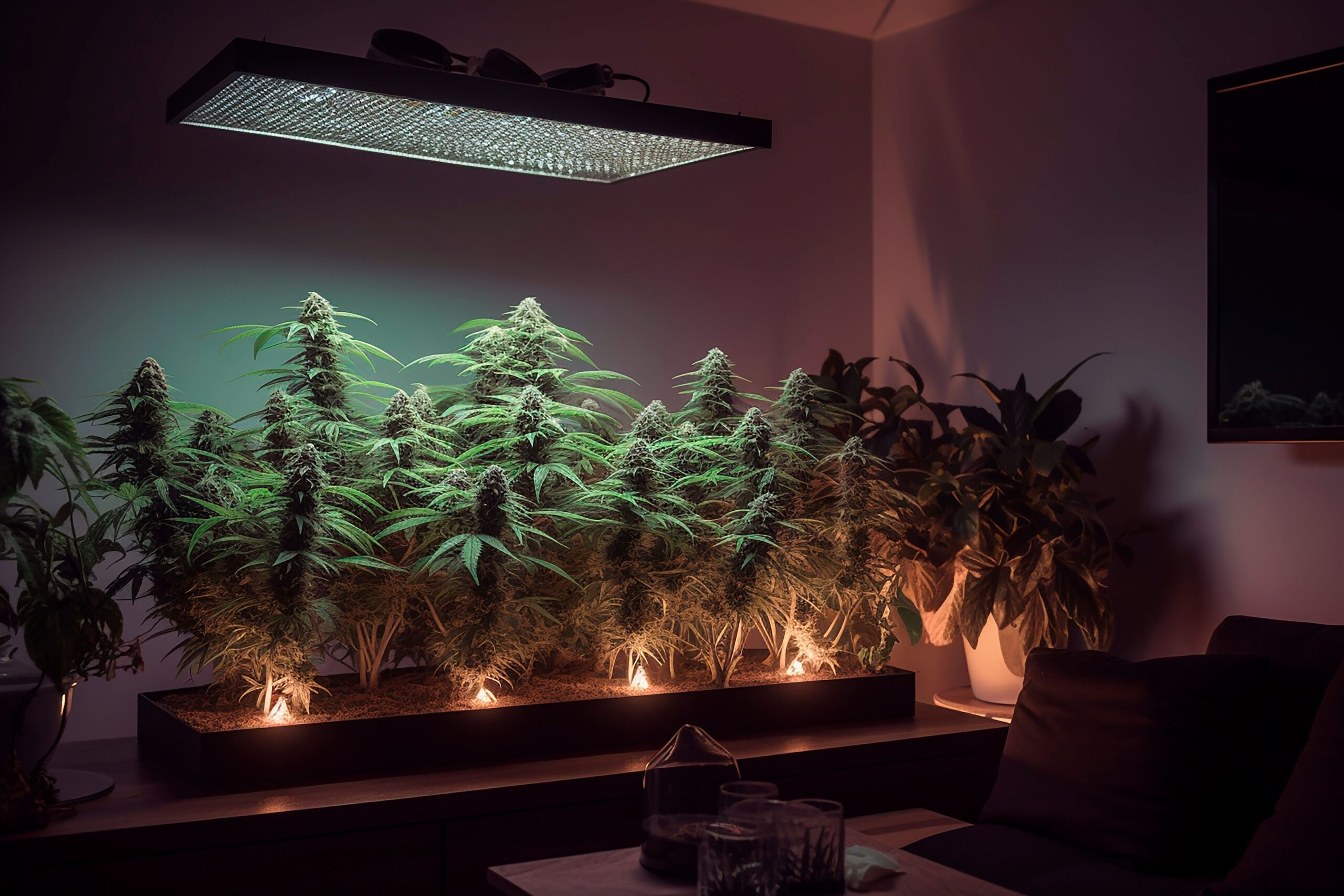<p>Growing cannabis indoors opens up a world of opportunity for enthusiasts and professionals, offering unparalleled control over the cultivation process. This method of cultivation isn't tied to seasonal constraints or the vagaries of outdoor weather, enabling you to grow cannabis all year long, even in compact spaces like apartments.</p>
<h2>Key Advantages</h2>
<p>Indoor cultivation allows you to manage the quality like never before: from tweaking nutrients and perfecting lighting to controlling the overall environment for optimal plant development. This means you can enjoy year-round cultivation, irrespective of external weather conditions. Additionally, by controlling your plants’ flowering cycles, you can reap multiple harvests annually. This method also provides the discretion and security needed for personal grows.</p>
<h2>Choosing the Right Space</h2>
<p>Even modest spaces can be converted into effective grow areas. Many indoor cultivators find success using spaces such as spare closets, basements, cabinets, or grow tents. Ensuring proper ventilation is crucial in these settings. A nearby window can be advantageous for exchanging air, thus managing both heat and odor effectively.</p>
<h3>Plan Your Layout</h3>
<p>Strategically setting up your grow space is fundamental for success. Allocate room for plants and pots, lighting fixtures, fans, and air filters. Make space for work areas to tend to your plants. Remember, cannabis plants significantly increase in size during the flowering stage, so ensure you have ample vertical space for growth.</p>
<h2>Controlling the Indoor Climate</h2>
<p>Cannabis plants are highly sensitive to their surroundings, necessitating precise control of temperature, humidity, and airflow. Achieving the ideal conditions for each growth stage is critical. For instance, while seedlings thrive in temperatures of 75-85°F with about 70% humidity, the vegetative stage prefers slightly lower humidity between 40-60% at similar temperatures.</p>
<h3>Tools You’ll Need</h3>
<p>Equip your grow room with essential tools like a thermometer to monitor conditions, a hygrometer for humidity, and devices like dehumidifiers or air conditioners to adjust the climate. Oscillating fans are also key for air circulation, ensuring your plants can breathe and develop strong stems.</p>
<h2>Selecting Your Grow Lights</h2>
<p>The selection of proper lighting is paramount for successful cannabis growth indoors. The light cycle is crucial: the vegetative stage requires 18 hours of light daily, reducing to 12 hours during the flowering stage.</p>
<h3>Types of Grow Lights</h3>
<p>Grow lights vary widely in form and function. HID lights, including Metal Halide for vegetative phases and High-Pressure Sodium for flowering, deliver intense light but generate substantial heat. Fluorescent lights such as T5s are budget-friendly, with lower output suitable for smaller operations. LEDs, while pricier upfront, offer full-spectrum light, are energy-efficient, and exhibit reduced heat output, promoting better yields.</p>
<h2>Airflow and Ventilation</h2>
<p>Effective air circulation is indispensable for cannabis growth. A lack of airflow can lead to mold, pest infestations, and nutrient deficiencies. A well-designed ventilation setup includes an exhaust fan at the top to expel warm, stale air, coupled with an intake vent at the bottom to draw in fresh air. Oscillating fans should be positioned to maintain air movement throughout the space.</p>
<h2>Growing Medium Options</h2>
<h3>Soil</h3>
<p>Soil is often the simplest choice for beginners. Choose high-quality organic soil that is free from extended-release fertilizers. "Super soil" blends can provide all necessary nutrients throughout the plant’s lifecycle, simplifying the process.</p>
<h3>Hydroponics</h3>
<p>Hydroponics represents a more advanced cultivation technique where roots are suspended in nutrient-rich water, often resulting in faster growth and higher yields. However, it demands a more complex setup and higher initial investment.</p>
<h2>Choosing the Right Containers</h2>
<p>The choice of containers can significantly impact plant health. Plastic pots are affordable but less breathable. Fabric pots improve root health by allowing air penetration but require more frequent watering. Ceramic pots maintain stable temperatures but are heavier and offer less drainage. For optimal results, start with 1-gallon pots and transplant to 5-7 gallon containers as growth progresses.</p>
<h2>Daily Plant Care</h2>
<h3>Watering</h3>
<p>Water with clean, drinkable tap water at a temperature of 65-75°F. Avoid overwatering by allowing the soil to dry slightly between sessions. Using a pH meter helps maintain water pH around 6.0-7.0, crucial for nutrient absorption.</p>
<h3>Nutrients</h3>
<p>Introduce nutrients gradually, alternating between nutrient-rich feedings and plain water to avoid overwhelming the plants. Monitor daily, ensuring water, pH, and nutrient levels are optimal, inspect for pests, and ensure environmental controls are functioning.</p>
<h2>Understanding the Growth Timeline</h2>
<p>Cannabis cultivation is structured around key growth stages: germination (3-10 days), seedling (2-3 weeks), vegetative (3-16 weeks), and flowering (8-11 weeks). The total cycle spans 3-8 months, depending on plant size and strain, with explicit control over flowering through light cycle management.</p>
<h2>Managing Odor</h2>
<h3>Why Odor Increases</h3>
<p>During flowering, cannabis plants release aromatic terpenes, intensifying the smell in warm, humid conditions. Efficient odor management solutions include proper ventilation, carbon filters, and climate control to keep humidity and temperature steady.</p>
<h3>Odor Control Methods</h3>
<p>Effective odor management utilizes exhaust fans to expel air and carbon filters to neutralize smell particles. Odor gels offer temporary solutions, while maintaining climate is crucial for ongoing odor control.</p>
<h2>Common Problems to Watch For</h2>
<p>Being vigilant is key to healthy plants. Common issues include mold and mildew from high humidity, pest infestations beneath leaves, nutrient burns resulting in yellowed leaf tips, and root rot from excessive watering.</p>
<h2>Final Thoughts</h2>
<p>Embracing indoor cannabis cultivation grants growers comprehensive control over plant health, yield, and quality. While the process demands learning and effort, success can be achieved by beginning small, adhering to a consistent care routine, and leveraging the guidance from industry leaders like Canna Daily News. Align your goals with expertise and reap the benefits of potent and bountiful harvests.</p>
<p>#CannabisNews #IndoorCannabisCultivation #CannabisGrowingTips #CBDTrends #HempInnovations</p>



